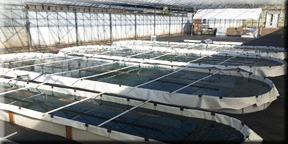Spirulina Ladies
APS Example: Spirulina Ladies of Chad
For many generations, Kanembu women have passed from mother to daughter the traditional methods of harvesting spirulina from Lake Boudou Andja in Chad to make dihé.

Spirulina ladies harvesting spirulina from Lake Boudou Andja. (Photos by Marzio Marzot from the FAO Report: The Future is an Ancient Lake, 2004).
When the rains stop, Kanembu ladies scoop the wet algae in clay pots, drained out the water through bags of cloth and spread out the algae a circular sand filter to dry in the sun. After about 20 minutes of drying, women cut the algae cakes into small squares for sale in the local market.

Ladies harvesting and traditionally drying spirulina dihé in a sand filter. (Photos by Marzio Marzot from the FAO Report: The Future is an Ancient Lake, 2004).

Selling dihé in the local market. Locals use dihé sauce poured over millet. (Photos by Marzio Marzot from the FAO Report: The Future is an Ancient Lake, 2004.)
In 2004 the United Nations Food and Agriculture Organization (FAO) reported in the Kanem region of Chad, the local market price ranged from $.80 to $2 per kg – more than 10 times less than spirulina sold in developed countries. The average consumption of dihé could be as high as 50 grams per person per week. More than 250 dry tons per year is produced, making these ladies of Chad nearly the highest volume and certainly the lowest cost producer of spirulina in the world.

Since 2007, improved methods for filtering, processing, drying and packaging have been introduced.
New 2011 Video “The Women Producers of Spirulina in Brandji Chad”
Les femmes productrices de spiruline à Brandji Tchad. 2011.
Thanks to Georges Bonnin for providing recent information on this project.

 SF Bay Area Spirulina Microfarm
SF Bay Area Spirulina Microfarm



